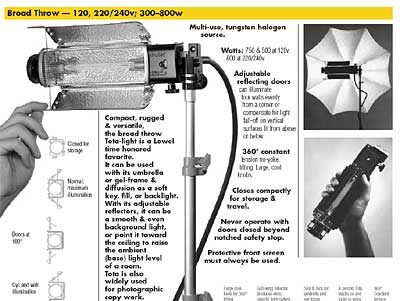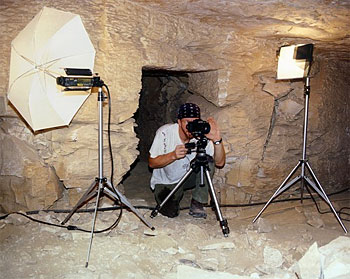| griff and hot lights
I've been distracted the last couple of days. My sister, Madelane, called up Tuesday night. She is the one that sent for the information that I've been putting up on the site about my grandfather: Griff's Story. He was a naval combart artist in WWII. I've scanned the paintings, sketches, and drawings that were in his books but I've wanted to getter better quality images. The Naval Historical Center, in Washington, D.C. (the wrong Washington), has 53 pieces by Griff. The Naval Historical Center allows people to come in and take copy pictures of their collection and I've mentioned this to Madelane. Tuesday she told me she has enough money coming back on taxes to fly the both of us back to D.C. so I can shoot Griff's pictures. Now I need to write a letter to the Naval Historical Center and find out how we can make it happen.
I also need to figure out how to shoot flat art. I have a good camera for this — a medium format Mamiya Universal. But, for me, using studio lights has been one of those mysteries of life. I've been wanting to get some strobes but I haven't been able to afford them. Shooting Griff's pictures means I will need to do something for not a lot of money. So Googlin' I went. The Internet will reveal all. Using continuous tungsten lights seemed cheaper than strobes. You know, the round aluminum reflector you get at a hardware store with a significant light bulb in it.
Using One Light
Controlling Light for Photography
Not only is this article about using tungsten lights it's about using one light. That sounds good. It has to be half the price of two lights, right? Well, it was even better than that.
| |
While a studio-type electronic flash unit has the advantage of producing a big punch of dependable, daylight-balanced light, even modest units are much more expensive than a tungsten source. Additionally, a flash meter is required and Polaroid film tests are almost unavoidable if you want to see what the lighting looks like in advance. This poses no financial problem for a pro, but it’s a sizeable investment for those with more limited means. This article will emphasize what you can do using using an economical 500–750W tungsten-halogen (quartz) mini-light. Tungsten-halogen illumination consistency is far greater than short-life photo floods you may have used years ago. Most large camera stores carry them. With their continuous-burning illumination, what you see is what you get—no Polaroid is needed; and your in-camera light meter can be used to determine the exposure.
The Lowell Tota-light is one such mini-light. Smith-Victor makes one too; they call it (odd-ly) a Broad Light. With light stand, umbrella and a few accessories, the total package costs about $300—about a third of the cost of the cheapest, entry-level studio-type electronic flash power pack, lamp unit, stand, flash meter and necessary accessories. I like the Tota-light because it accepts an umbrella directly without a separate swivel umbrella adapter.
| |
It also talks about how shooting flat art with only one light is really a good idea. This is what I wanted to hear.
| |
Here’s where one light is better, even though many lighting texts routinely describe a formula for using two. One light is cleaner, more flexible, and superior when flat art has dimension. Examples: brush strokes in a painting are best seen under singular illumination; a fan of prints laid across a surface are better rendered with a unifying shadow edge; and textured paper is properly revealed under one light, but not two.
| |
[more]
I started to search on Lowel Tota-lights and found all sorts of encouraging comments.
Lowel-light
| |
My first Lowel lights were the Tota-lights because they fold up to a small shape. In their folded form they are totally protected and travel well (all over the world, have never lost a Lowel Tota-light in over twenty-five years). I have used Lowel Tota-lights even outside in the tropical jungles of Belize, Central America. At the remotest Maya ruins in Mexico, Honduras, and Guatemala, Lowel Tota-lights have aided in recording, and hence rescuing, information about ancient cultures.
Lowel lights are used world wide. When I was photographing in Australia, I saw Lowel lights in the leading museum of that far away continent. When I was visiting in Denmark, the PhaseOne studio included Lowel lights.
| |
[more]
Bill Pierce's Nuts & Bolts
"Hot Lights"
| |
Stupid Suggestion: Now comes the stupid suggestion. To learn lighting, use tungsten and halogen lights. Still photographers tend to stick to electronic flash. But, I remember being knocked out by the studio portraiture of a young photographer who lit his subjects with household bulbs in hardware-store-type aluminum reflectors. (I also know some old pros who use tungsten.) When you can see it, you really can be more creative with it.
The movie industry has provided us with a lot of lightweight location gear. Lowel-Light makes a huge variety of location gear. Probably the most popular are: (1) the Tota light, a small, rugged flood with a folding gull wing reflector that provides a variety of light patterns and bulb protection when the unit is being transported; (2) the Omni light with a parabolic reflector that can produce a beam angle from 16 to 53 degrees with a standard reflector. Bigger units, smaller units, soft boxes, even focusing spotlights with fresnel lenses, and an unbelievable range of accessories are all available.
| |
[more]
By now I'm getting pretty stoked about these Tota-lights. I checked B&H Photo and they are going for $110 which is a whole lot less than strobes and these seem like real quality units. On to the Lowel site...
lowel

[more]
Unfortunately, all the Lowel catalog pages are PDF files but that's OK. Nice stuff! The Theban Mapping Project uses Tota-lights...

Tota-light, stand, lamps, and umbrella for around $215. Add some foamcore for a reflector and I'm in business. Of course, if I write to the Naval Historical Center and they already have high quality copy negs of Griff's work, I will be disappointed. Not really. I've wanted to do studio lights for a long time and this seems a really good way to do it. I'm excited. And Lowel even has a book on lighting I need to get. It's in my Amazon wish list.
|

